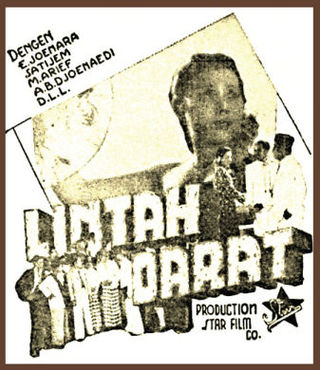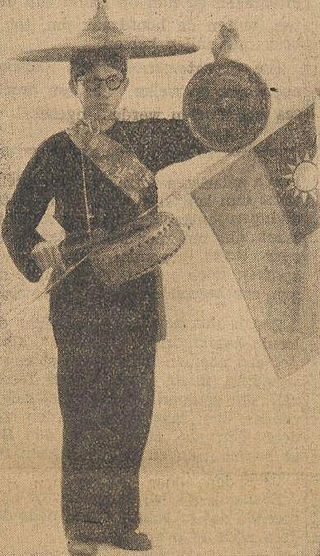Release and reception
Huwen op Bevel was released in 1931, although several sources list it as being from 1932. It screened in Batavia (now Jakarta) in August, reaching Medan in late September and Surabaya by mid-October. The film was advertised as having full sound, including music and singing. Later advertisements compared it with Tan's production, Njai Dasima. It was advertised as the first sound film in the Indies and referred to as such by some later writings. Biran, however, writes that Krugers's earlier film Karnadi Anemer Bangkong featured sound.
Huwen op Bevel received negative reviews. One in the Batavia-based Het Nieuws van den dag voor Nederlandsch-Indië found the film to lack contrast and have poor vocal synchronisation; the reviewer summarised that "turning the crank is not enough; a filmmaker must master the technique". [lower-alpha 1] The film was a commercial failure and proved Krugers's last film. He left the Indies in 1936 and moved to Hong Kong, where he died in 1937.
Huwen op Bevel is likely a lost film. The American visual anthropologist Karl G. Heider writes that all Indonesian films made before 1950 are lost. However, JB Kristanto's Katalog Film Indonesia (Indonesian Film Catalogue) records several as having survived at Sinematek Indonesia's archives, and Biran writes that several Japanese propaganda films have survived at the Netherlands Government Information Service. Some contemporary reviews gave Indonesian-language translations of the title, like Nika Terpaksa. More recent sources have given the translation Terpaksa Menikah.

Tan's Film was a film production house in the Dutch East Indies. Established by the brothers Tan Khoen Yauw and Tan Khoen Hian on September 1, 1929, its films were mostly targeted at native ethnic groups. Starting with Njai Dasima in 1929, the company released fifteen movies before ultimately being dissolved after the Japanese occupation. The Tans and the Wong brothers established Tan & Wong Bros in 1948 to continue this work.

Terang Boelan is a 1937 film from the Dutch East Indies. Written by Saeroen, directed by Albert Balink, and starring Rd Mochtar, Roekiah and Eddie T. Effendi, Terang Boelan follows two lovers who elope after one is almost forced to marry an opium smuggler. The film was shot in the Indies and Singapore, and was partially inspired by the 1936 Hollywood film The Jungle Princess. It was aimed at native audiences and included keroncong music, which was popular at the time, and several actors from Balink's previous work Pareh (1936).

Georgio Eduardo Alberto Krugers was a cameraman and film director active in the Dutch East Indies during the early 20th century. He is recorded as having worked in film since the mid-1920s, and in 1927 he made his directorial debut, Eulis Atjih. He joined hajj pilgrims in 1928 and screened a resulting documentary, The Great Mecca Feast, in the Netherlands. His 1930 film Karnadi Anemer Bangkong is thought to be the first talkie in the cinema of the Indies, but was a commercial failure as the majority Sundanese audience considered it insulting. After making two works for Tan's Film in the early 1930s, Krugers moved to Hong Kong and then the Netherlands.

Loetoeng Kasaroeng is a 1926 fantasy film from the Dutch East Indies which was directed and produced by L. Heuveldorp. An adaptation of the Sundanese folktale Lutung Kasarung, the film tells of a young girl who falls in love with a magical lutung and stars the children of noblemen. Details on its performance are unavailable, although it is known to have been of poor technical quality and thought to have performed poorly. It was the first film produced in the country and the first to feature a native-Indonesian cast. It is likely a lost film.
Karnadi Anemer Bangkong is a 1930 comedy from the Dutch East Indies directed by George Krugers. It is considered the country's first talkie, although parts were silent and the sound quality was poor. Based on a popular Sundanese novel, the film was considered controversial by the native audience.

Indonesia Malaise is a 1931 film directed by the Wong brothers. It was the brothers' first sound film and one of the first such films in the Dutch East Indies. Billed as a comedy, the story follows a woman who is overcome by tragedy in her personal life. A commercial failure, it may be lost.
De Stem des Bloeds, also known as Njai Siti, is a 1930 film from the Dutch East Indies. It was directed by Ph. Carli and starred Annie Krohn, Sylvain Boekebinder, Vally Lank, and Jan Kruyt. The film follows a man and his mistress who reunite after their son and step-daughter unwittingly fall in love. The black-and-white film, which may now be lost, was tinted different colours for certain scenes. It was released in early 1930 to commercial success, although critical opinion was mixed.

Gagak Item is a 1939 bandit film from the Dutch East Indies directed by Joshua and Othniel Wong for Tan's Film. Starring Rd Mochtar, Roekiah, and Eddy T. Effendi, it follows a masked man known only as "Gagak Item". The black-and-white film, which featured the cast and crew from the 1937 hit Terang Boelan, was a commercial success and received positive reviews upon release. It is likely lost.

Zoebaida is a 1940 film from the Dutch East Indies directed by Njoo Cheong Seng. A romance set in Timor, it starred Njoo's wife Fifi Young and was the film debut of Soerip. Shot over a period of 27 days in a Dutch-owned studio, the film received middling reviews. It is likely lost.

Ikan Doejoeng is a 1941 film from the Dutch East Indies directed by Lie Tek Swie and starring Asmanah and Soerjono. Following star-crossed lovers, the film was the first released by Standard Film. Likely targeted at the educated elite, it is now probably lost.

Sorga Ka Toedjoe is a 1940 film from the Dutch East Indies directed by Joshua and Othniel Wong for Tan's Film. It follows an older couple who are reunited by another, younger couple after years of separation. The black-and-white film, the first production by Tan's Film after the departure of Rd Mochtar, featured kroncong music and was targeted at lower-class native audiences. It was a commercial and critical success. Roekiah and Djoemala took leading roles in three more films before Tan's closed in 1942. Sorga Ka Toedjoe is now thought lost.
Njai Dasima is a 1932 film from the Dutch East Indies which was directed by Bachtiar Effendi for Tan's Film. It was the second film adapted from G. Francis' 1896 novel Tjerita Njai Dasima, following a silent version in 1929. Starring Momo and Oesman, it followed a young Sundanese njai (concubine) who is tricked into marrying a man who does not love her and ultimately killed for her money. The film, the first talkie produced by its company, was also the first directed by a native Indonesian. The now-lost work received mixed critical reception.

Lintah Darat is a 1941 film from the Dutch East Indies directed by Wu Tsun and produced by Jo Eng Sek.

Poesaka Terpendam is a 1941 film from the Dutch East Indies produced by Tan's Film and starring Roekiah, Djoemala, and Kartolo.

Star Film was a film production company in the Dutch East Indies. Established by Chinese-Indonesian businessman Jo Eng Sek and Chinese cameraman Cho' Chin Hsin in 1940, it produced five black-and-white films in 1940 and 1941; two of these were directed by Jo, and the remainder were directed by Wu Tsun. Another film was under production when the studio was closed following the Japanese occupation of the Dutch East Indies. Star helped establish the careers of actors such as S Waldy and Elly Joenara, and produced screenplays written by Rd Ariffien and Saeroen; its output, however, is probably lost.

Soeara Berbisa is a 1941 film from the Dutch East Indies. Produced by Ang Hock Liem for Union Films and directed by R Hu, this black-and-white film stars Raden Soekarno, Ratna Djoewita, Oedjang, and Soehaena. The story, written by Djojopranoto, follows two young men who compete for the affections of a woman before learning that they are long-lost brothers.

Oriental Film was a film production company in Batavia, Dutch East Indies. Established by ethnic Chinese businessman Tjo Seng Han in 1940, it completed four black-and-white films before it was closed in 1941. All the company's films were screened into the 1950s but may now be lost. They were directed by two men, Njoo Cheong Seng and Sutan Usman Karim, and launched the careers of actors such as Dhalia and Soerip.

Louis Victor Wijnhamer, better known as Pah Wongso, was an Indo social worker popular within the ethnic Chinese community of the Dutch East Indies, and subsequently Indonesia. Educated in Semarang and Surabaya, Pah Wongso began his social work in the early 1930s, using traditional arts such as wayang golek to promote such causes as monogamy and abstinence. By 1938, he had established a school for the poor, and was raising money for the Red Cross to send aid to China.

Louis Johan Alexander Schoonheyt (1903-1986), commonly known as L. J. A. Schoonheyt, was a Dutch medical doctor, writer, and supporter of the National Socialist Movement in the Netherlands before World War II. From 1935 to 1936 he was the camp doctor at the Boven-Digoel concentration camp in New Guinea, Dutch East Indies, and is mostly known today for the book he wrote about his experiences there, Boven-Digoel: Het land van communisten en kannibalen (1936). His praise for the conditions in the camp earned him the ire of the internees, Indonesian nationalists, and Dutch human rights advocates; E. du Perron called him a 'colonial bandit', while many internees burned his book after reading it in the camp.

















